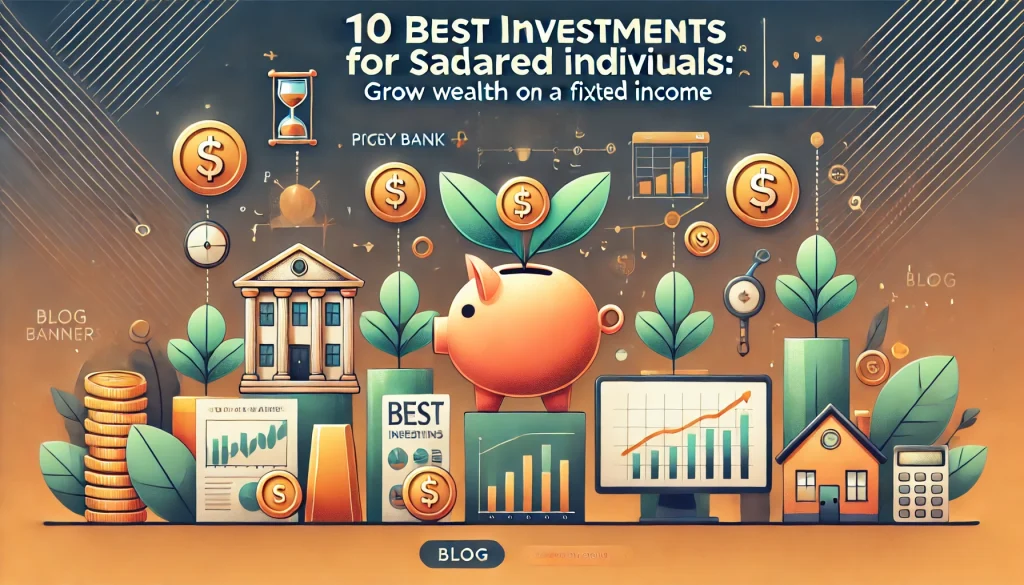
Investing in India has become popular as it helps individuals combat inflation, achieve their financial objectives, and secure their future. In today’s financial landscape, investors can channel their money into various investment options such as stocks, equities, mutual funds, and fixed deposits rather than keeping their money idle in the bank account.
In this comprehensive guide, we will provide you with insights into the best investment options in India to help you make informed decisions and build a secure future.
What is an Investment?
Investment refers to the asset acquired with the aim of generating income or profit in the future. Investing involves actively deploying capital, in the form of money, time, effort, or other resources, with the hope that you will get back more in future than what you started with.
Successful investment requires careful analysis of various factors, including potential risks, market conditions, asset performance, and financial goals. Few good investment options in India involve high risk but have the potential to provide long-term returns compared to other options. Therefore, choosing an investment plan might be challenging yet rewarding to build your financial security.
Types of Investment Options in India
The best investment options in India can be categorised based on their risk levels, which range from low to high. The following provides a brief idea of the different types of investment options you can avail:
1. Low-Risk
These investments include very minimal to no risk, ensuring stable and guaranteed returns. Low-risk investments include fixed-income instruments and are ideal for those people who want to earn guaranteed returns. Examples of low-risk investments include fixed deposits, the Public Provident Fund, and the Sukanya Samridhi Yojana.
2. Medium-Risk
Medium-risk investments are a little bit riskier than low-risk investments. They aim to provide decent returns while maintaining a moderate level of risk. These are suitable for investors looking for a balance between growth and stability. Examples of medium-risk investments include debt funds, corporate bonds, and government bonds.
3. High-Risk
High-risk investments are usually associated with higher levels of market risks. They aim to offer potentially higher returns in the future, but this comes with significant ups and downs. These are for investors willing to take greater risks and make gains from market fluctuations. High-risk investment examples include stocks, mutual funds, and Unit Linked Insurance Plans (ULIP).
Best Investment Options in India
Here is a list of the best investment options in India 2024, that will provide you with higher returns in future.
1. Fixed Deposit
It is one of the safest and best investment options in India that has flexible tenures, ranging between 7 days to 10 years, with attractive interest rates. It further offers additional interest rates to senior citizens upon making a deposit. The interests are paid on a monthly, quarterly, half-yearly, or annual basis and sometimes at maturity. Additionally, this type of investment provides tax benefits under Section 80C of the Income Tax Act.
2. Sovereign Gold Bonds (SGB)
Introduced by the Government of India in November 2015, Sovereign Gold Bonds (SGBs) act as an alternative investment to physical gold. Government issues these bonds as securities denominated in grams of gold, and are available in multiples of 1 gram.
SGBs are regarded as a secure investment plan, facilitating transparency between an investor and the government. You can invest in SGBs by contacting a SEBI-authorised agent or broker. When you redeem them, the invested amount is credited to your registered bank account based on the current market value.
3. Mutual Funds
It is an investment fund that pools money from multiple investors to purchase securities like money market instruments, stocks, bonds, and other assets. Mutual funds provide individual or small investors with the opportunity to access professionally managed diversified portfolios. These funds are categorised based on the securities they invest in, their investment goals, and the returns they seek. Many employer-sponsored retirement plans typically consider mutual funds as investment options.
4. Stocks
Known as equity investment, investing in stocks signifies buying a part of a company. With stocks, you can earn income from dividends and profit from capital appreciation. Stock returns depend on the market, making them the riskiest investment. To invest in stocks, it is best to have a long-term perspective since short-term fluctuations may lead to unexpected losses.
5. Public Provident Fund (PPF)
Public Provident Fund (PPF) is one of the low-risk investment plans introduced by the National Savings Institute and offered by private and nationalised banks in India. The Government of India fully guarantees this secure investment option. PPF comes with a 15-year lock-in period, but you can extend it in 5-year increments if you want. Additionally, PPF serves as a valuable tax-saving investment.
6. National Pension System (NPS)
Primarily designed for long-term retirement planning, the National Pension System (NPS) is an investment product that blends assets such as stocks, government bonds, and corporate bonds. Additionally, with this investment plan, you have the flexibility to choose the allocation of your money among the asset classes according to your risk tolerance.
7. Post Office Monthly Income Scheme
It is one of the best investment options in India, popular among housewives and individuals with passive income who are seeking investment opportunities to generate returns. With the Post Office Monthly Income Scheme, your money remains secure as the government backs it, and it is not subject to any market risks.
8. Senior Citizen Savings Scheme (SCSS)
This scheme is a post office savings plan exclusively designed for senior citizens. It aims to offer a steady income to retired senior citizens. It has a 5-year tenure and can be extended by 3 more years. Senior Citizen Savings Scheme requires a minimum investment of ₹1,000 and the maximum amount can go up to ₹30 lakhs.
9. Unit Linked Insurance Plan (ULIP)
A Unit-Linked Insurance Plan (ULIP) merges life insurance with investment. It allocates a portion of your premium into assets like stocks and bonds to grow your wealth over time and another part of your premium secures a life insurance coverage. This investment option offers flexibility by helping you to switch between different funds based on their financial objectives and market conditions.
10. Gold ETFs
A Gold ETF is an exchange-traded fund that represents gold in paper or dematerialised form. Each Gold ETF unit equals 1 gram of gold. When you buy Gold ETFs, you acquire electronic gold, and when you redeem them, you receive cash instead of physical gold.
Investing in Gold ETFs offers transparency in gold pricing and has lower costs compared to physical gold. It is suitable for those who want to invest in gold without dealing with storage or purity concerns and seek potential tax benefits.
11. Real Estate
Real estate investment involves buying, owning, and managing physical properties like land, buildings, or real estate. It involves selling these properties at a higher price in the future or earning regular income through rent. This type of investment is most suitable for long-term investors because property values do not change significantly in the short term.
12. P2P Lending
This is one of the trending and top investment options in India that offers financial services by connecting borrowers with investors online. Here borrowers can avail affordable loans, while investors can earn higher returns. P2P platforms act as an intermediary, making lending transparent and efficient. As per a report, the P2P lending market in India is expected to grow at 18.6% CAGR from 2020 to 2028.
13. Corporate Bonds
A corporate bond is a mutual fund that allocates over 80% of its total financial assets into corporate bonds. Companies issue these bonds to cover short-term expenses like working capital, advertising, insurance premiums, and more. Businesses are increasingly favouring corporate bond funds as a cost-effective means of raising necessary funds compared to bank loans.
14. Government Bonds
The government issues a type of debt security known as a government bond to raise funds for various purposes, such as building infrastructure or funding social programs. When you buy a government bond, you are essentially lending your money to the government. In return, the government promises to pay you interest at a fixed rate for a specified period, typically ranging from a few months to several years.
At the bond’s maturity, the government pays back the initial borrowed amount to you. Government bonds are considered low-risk because the government’s full faith and credit back them, resulting in an extremely low chance of default.
15. Physical Gold
It is one of the most preferred and traditional investment options in India. You can hold gold in tangible forms like jewellery, coins, or bars, often referred to as bullion. It serves as a hedge against market risks and provides liquidity. While gold does not offer regular income in the form of dividends or interest, it can provide returns that beat inflation.
Things to Keep in Mind Before Investing
Sometimes choosing the most suitable investment plan from a wide range of options can pose a challenge. Here are some important points you should keep in mind before prioritising one.
1. Investment Goals
Match your investment objectives with the right assets since not all investments suit everyone. For long-term goals like education and retirement, consider equities. For short-term goals, think about FDs and fixed-income options.
2. Lock-in Period
Be aware of lock-in periods as some investments, such as PPF and FDs, have fixed holding durations. Premature withdrawals may incur penalties.
3. Investment Horizon
Different investments have different tenures such as FDs for 5 years, PPFs for 15 years, and mutual funds usually need at least 3 to 5 years. Choose an investment option that suits your financial goal’s time horizon.
4. Return Expectations
Not all investments offer the same returns. High returns often come with high risk. Understand an asset’s historical performance to gauge its potential.
5. Risk Assessment
Every investment carries a certain level of risk or volatility. Stocks are more volatile, while fixed deposits offer guaranteed returns. Invest in assets whose risk aligns with your risk tolerance.
6. Costs and Expenses
Each investment comes with costs like transaction fees or management charges. Opt for options with lower expenses to maximise your returns.
7. Liquidity
Ensure your assets offer good liquidity. Some investments are easy to convert to cash, while others, like real estate, may tie up your money.
8. Taxation
Returns from investments are taxable. Learn about the tax implications for each investment, as they vary. Use online income tax calculators to estimate your tax liability.
Now that you have a clear idea of the different best investment options in India, choose one that aligns with your investment goals, risk tolerance, and investment horizon. Before investing, carefully consider factors like your investment goals, the lock-in period, expected returns, risk assessment, costs, liquidity, and taxation implications. Additionally, you must stay informed about economic and market conditions, as well as any alterations in regulations or industry trends that could have an impact on your investments.
FAQs
A minimum investment of ₹1,000 is required to open an account for the Post Office Monthly Income Scheme.
To avail the best investment plan in India you need to provide documents such as KYC documents, PAN card, bank details, Form 16, and income proof documents if applicable. However, these documents may vary from one investment to another.
Fixed Deposits, Senior Citizen Savings Scheme (SCSS), Post Office Monthly Income Scheme, Public Provident Fund (PPF) and Government Bonds are the safest investment options in India.
The maturity period of Sovereign Gold Bonds is 8 years from the date of your investment.
Mutual funds, PPF, NPS and Real Estate are a few good investment options that are perfect for salaried individuals.


